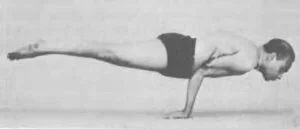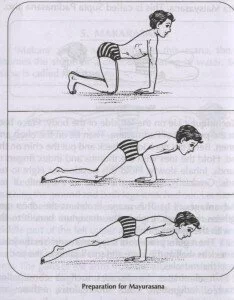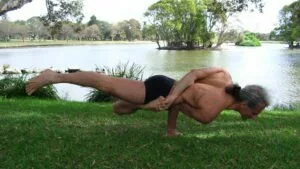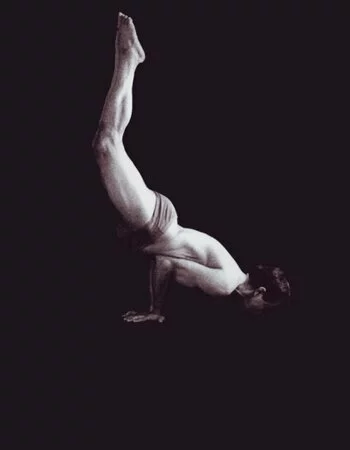 Mayurasana (Sanskrit: मयूरासन) or Peacock Pose is an asana where the individual assumes a peacock-like posture. This asana tones up the abdominal portion of the body. It also strengthens the fore arms, wrists, and elbows.
Mayurasana (Sanskrit: मयूरासन) or Peacock Pose is an asana where the individual assumes a peacock-like posture. This asana tones up the abdominal portion of the body. It also strengthens the fore arms, wrists, and elbows.
The name comes from the Sanskrit words Mayura (मयूर) meaning “peacock” and asana (आसन) meaning “posture” or “seat”.
In this asana, oneself is raised like a horizontal stick holding the floor with both palms while the body is supported by the elbows. Kalachakra thangka from Sera Monastery (private collection). In Tibetan Buddhist and Indian Hindu/Buddhist traditions, Shambhala (also spelled Shambala or Shamballa; Tibetan: བདེ་འབྱུང་; Wylie: bde ‘byung, pron. de-jung; Chinese: 香巴拉; pinyin: xiāngbālā) is a mythical kingdom hidden somewhere in Inner Asia. It is mentioned in various ancient texts, including the Kalachakra Tantra and the ancient texts of the Zhang Zhung culture which predated Tibetan Buddhism in western Tibet. The Bön scriptures speak of a closely related land called Olmolungring. Hindu texts such as Vishnu Purana mention Shambhala as the birthplace of Kalki, the final incarnation of Vishnu who will usher in a new Golden Age (Satya Yuga). Whatever its historical basis, Shambhala gradually came to be seen as a Buddhist Pure Land, a fabulous kingdom whose reality is visionary or spiritual as much as physical or geographic. It was in this form that the Shambhala myth reached the West, where it influenced non-Buddhist as well as Buddhist spiritual seekers
Step by Step:-
- Sit on your heels with the knees wide apart. Bring the hands and forearms together, palms upwards.

- Leaning forward, place the hands flat on the floor with the fingers pointed in towards the body. Elbows are bent slightly while the sides of the hands and the elbows are joined together.
- Press your elbows into the midriff area
- Keep your belly firm and drop your head to the floor.
- Straighten the knee and stretch one leg straight back and bring the other leg out beside it. The upper part of the feet should be on the floor.
- Keep your buttocks firm and your shoulders rounded slightly downwards.
- Raise the head up and gaze forward
- Shift the weight forward with the buttocks, keeping the legs firm and strong.
- As the weight shifts, the feet should come off the ground.
- The body should be aligned on the hands and parallel to the floor.
- Rest in this position for 10 seconds and steadily increase the time to one minute.
- Release your feet and head to the floor.
- Repeat this 2 to 3 times.
Precautions:-
- Avoid this pose in case of any elbow, shoulder or wrist injury.
- Avoid Peacock Pose during pregnancy and menstruation.
- Avoid this pose in some medical conditions like hernia, ulcers, heart disease, high blood pressure, brain tumor, complicated intestinal problems, and eye, ear or nose infections.
- The Peacock Pose detoxifies and releases toxins, therefore, decrease the time and repetitions of the pose, in case you feel unwell during the practice.
Beginner’s Tip:-
If you are a beginner to the pose you could use some beginner’s tips to help you. Bind the elbows together with a strap if they tend to slide apart and place the strap above the elbows. In order to help you with balance, place a block under the forehead and/or front ankles. It is recommended that you perform the pose with directions from a trained yoga teacher.
Benefits:-
According to the ancient text Gerunda Samhita “The peacock posture cancels the effects of unhealthy food: it causes heat in the stomach and eliminates the effects of deadly poisons; it effectively cures diseases, like tumors and fever, such is this useful posture.” The benefits of the pose include the following.
- Peacock Pose builds pressure towards the abdomen, by which the blood is directed to the digestive organs. With increased intra-abdominal pressure, the abdominal area is toned.
- The liver, spleen, pancreas, and stomach are revitalized. The nerves and muscles connected with the intestines and kidneys are rejuvenated.
- The lethargy of the liver is said to be alleviated.
- The Peacock Pose fights against problems related to constipation, piles, diabetes, and indigestion.
- The Peacock Pose, if practiced in the morning, reduces acidity.
- The Peacock Pose strengthens the reproductive organs and improves sexual activity.
- The Peacock Pose helps to relieve all problems caused by excess bile, wind, or phlegm.
- With regular practice of the Peacock Pose, the body easily digests the food eaten indiscriminately and immoderately.
- The pose counteracts the effects of overeating and consumption of rich, greasy foods.
- The arm muscles and the core are strengthened.
- The shoulders, elbows, and wrists are strengthened.
- The Peacock Pose improves back and legs muscles.
- The Peacock Pose reduces stress and calms the mind.
 Therapeutic Applications:-
Therapeutic Applications:-
- Improves digestion
- Relieves constipation
- Alleviates Stress
- Promotes liver health
- Improves body and mind coordination and balance
- Enhances concentration and determination
- Promotes physical and mental balance
- Removes lethargy
Variations:-
- The feathered Peacock Pose or Pincha Mayurasana is the advanced variation of the Peacock Pose. This pose requires a lot of practice, strength, and flexibility. The steps for this pose are illustrated below.
- First, start with Downward Facing Dog (Adho Mukha Svanasana), near a wall.
- Place the forearms and the palms on the floor. The forearms should be parallel to each other and the fingertips at the base of the wall.
- The shoulder blades should be firm against the back and pulled towards the tailbone.
- Hug the forearms inward and rotate the upper arms outward. Spread the palms and place inner wrists firm on the floor.
- Bend the knee and bring the left foot in, close to the wall. Extend the right leg towards the wall and lift the left foot off of the floor, pushing the heel to straighten the leg.
- Exhale and jump up and down several times, each time trying to push off the floor slightly higher.
- At first, jumping up and down maybe all you can manage, but regular practice of the Downward Facing Dog Pose or the Plank Pose will help you to achieve the required position.
- In the feathered Peacock Pose, the head should be off the ground. Place the head in between the shoulder blades and keep your look fixed into the middle of the room.
- Stay in this pose for 10 to 15 seconds and slowly take it up to one minute. Do not land on the shoulders while coming down.
- Exhale and bring one foot down, keeping the shoulder blades upwards and wide.

- Repeat the same for another foot.
- Keep alternating the legs for the upward lift.
Preparatory Poses:-
- Four-Limbed Staff Pose (Chaturanga Dandasana)
- Seated Foot Behind the Head Pose (Eka Pada Sirasana)
Follow up poses:-
- Downward Facing Dog (Adho Mukha Svanasana)
- One-handed Arm Balance (Eka Hasta Bhujanasana)
- Shoulder Pressing Pose (Bhujapidasana)
- Child Pose (Balasana)
- Foot Behind the Head Pose (Eka Pada Sirasana)
- Four-Limbed Staff Pose (Chaturanga Dandasana)
Peacock Pose is one of those yoga poses which may seem difficult to perform in the beginning; however, practice and patience is the key. In the course of time, the body will find the balance and the fluidity required to perform the pose.
Cautions:-
Mayurasana is a very important balancing asana but demands physical strength. In this asana, the entire weight of the body remains on the navel and it is possible to lose balance at any moment. Those suffering from cervical spondylitis are not recommended to practice it.
